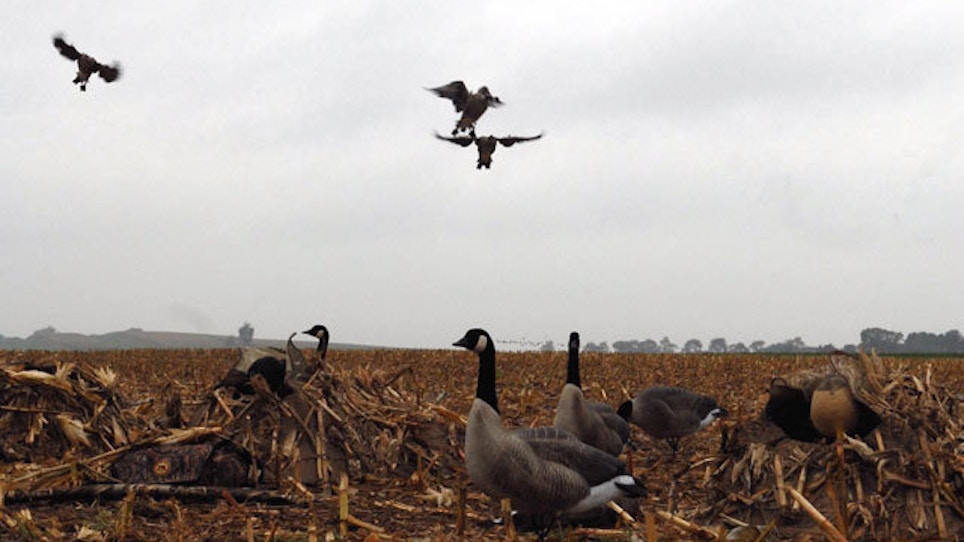From a distance, the flock looked like a short measure of black thread, slowly undulating against the slate-gray horizon.
“Geese!” one of the boys barked in a serious tone.
The four of us tucked into our layouts, eyes glued on the approaching birds. Two of us started hammering hail and feeding calls on our short-reeds. Another waved a T-shaped black flag.
At about a quarter-mile out, the honkers uniformly quit flapping their wings and glided toward our spread. I reached down with my right hand and gripped the stock of my shotgun.
Our calling quieted to a few clucks and murmurs. When they were 200 yards out, the geese seemed to catch an updraft and they rose just a few feet.
“They’re not going to do it,” someone said. “Don’t move. Let them circle.”
The geese sailed over our heads. I clucked fast and loud and gave a series of comeback cries. The honkers tipped sideways in the air, looped in a tight circle to get downwind, then dropped their feet to hit the hole.
“Take ’em!” I hollered, when the flock back-pedaled a few feet above the stubble. We cleaned the row, taking all eight birds.
It’s true that Canada geese are individuals. Hunt them long enough, however, and patterns in their behavior emerge. Recognize and understand those patterns to guide your hunting actions, and limits are sure to fall. When you do that, you’re reading the geese.
Totally Committed
Life is good and you can expect quick hunts when the birds totally commit to your setup. You want to see honkers zooming in on cupped wings that never straighten, but rather, curl harder the closer the geese get to the ground. These are the layups. Sit back, don’t move and wait for the shot.
Canadas that are totally committed are quick to drop their landing gear, and they don’t look around too much. Giants are likely to be moaning. The cacklers will probably cluck fast. Imitate the calls you hear, but do it softly and infrequently.
Remember, these geese are heading straight to the hole with reckless abandon. All you have to do is not screw it up. Don’t call like you’re trying to get the attention of flocks 500 yards away. Leave the flags alone.
The Sliders
Some days, it seems like every flock that works your rig got the same memo about not heading for the hole in the decoys you created right in front of your blinds. One after another, the flocks will center up the hole and then slide off to the side before they reach it. It’s really annoying.
Rest assured, there is no memo. If every flock — or most of them, anyway — are sliding off to the side of your spread, it’s because they’re all seeing something about the hole that they don’t like. Fix it. Move some decoys around to make the hole bigger, or maybe plant a couple in the middle so the opening is not so barren.
Also, when the geese start to slide, try having a hunter on the far side of the hole wave a flag. That bit of movement might be just the trick to pull the birds back to the landing zone. Callers on that side of the rig should try clucking fast.
For sure, if the geese set up to land off to the side of your spread, everyone with a call needs to cluck as fast and as loud as they can. Hopefully, this racket will keep the birds from landing, and convince them to circle back around downwind to attempt another approach.
If they land off to the side, you’ve lost. Maybe the hunter at the far end will have the possibility for a ground-swatting shot, but that’s about it. As long as they’re still in the air, you have a chance of working them into the hole. Geese that land and then take off are goners. They’re not coming back.
The Circlers
As the hunting season wears on, honkers that survive encounters with hunters are going to wise up. Count on it. These wary birds will likely approach your spread from a greater altitude. Their aim is to look things over before they decide if they’re going to land or bail. And this is when being able to read geese absolutely will mean the difference between putting birds in the bag or going home empty-handed.
Late-season, wary Canadas are likely to fly around your decoy spread as they hunt for some sign of danger. Hopefully, they’ll lose some altitude as they circle. Now the best scenario, which will yield the greatest shooting, is for the geese to drop lower and lower with each pass, until they hit the hole.
As long as the birds keep chattering and pulsing their wings slowly, you’re in the game. Call softly when these geese are coming toward you. Hammer them with clucks and comeback cries when they’re moving away.
If the geese are in range as they come toward you, and they suddenly start to flap their wings to gain altitude, call the shot. These are geese that have probably seen enough, and they don’t feel comfortable. Take what you can get. Bagging, say, four of eight geese is not as good as taking all eight, but it’s better than pulling a zero. Work enough flocks like that and you’ll scratch out a limit eventually.
Let the geese be your guide. Read their actions in the air to figure out yours on the ground. Hot barrels will follow.






